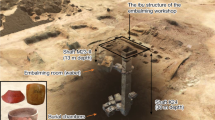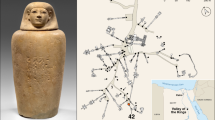Abstract
Millions of votive mummies of mammals, birds and reptiles were produced throughout ancient Egypt, with their popularity increasing during the reign of Amenhotep III (1400 bc) and thereafter. The scale of production has been taken to indicate that relatively little care and expense was involved in their preparation compared with human mummies1,2,3. The accepted view is that animals were merely wrapped in coarse linen bandages and/or dipped in ‘resin’ before death2,3,4. However, as with human mummification there was a range of qualities of treatments, and visual inspection of animal mummies suggests that the procedures used were often as complex as those used in humans (for example, evisceration and elaborate bandaging). Moreover, the ancient Egyptians treated animals with great respect, regarding them both as domestic pets and representatives of the gods; for example, the cat symbolized the goddess Bastet; the hawk, Horus; the ibis, Thoth, and so on. We report here the results of chemical investigations of tissues and wrappings from Pharaonic cat, hawk and ibis mummies using gas chromatography, gas chromatography–mass spectrometry, thermal desorption–gas chromatography–mass spectrometry and pyrolysis–gas chromatography–mass spectrometry5,6. The analyses reveal the presence of highly complex mixtures of n-alkyl and cyclic biomarker components characteristic of fats, oils, beeswax, sugar gum, petroleum bitumen, and coniferous, Pistacia and possibly cedar resins. The mixture of balms is of comparable complexity to those used to mummify humans from the same period6,7,8.
This is a preview of subscription content, access via your institution
Access options
Subscribe to this journal
Receive 51 print issues and online access
$199.00 per year
only $3.90 per issue
Buy this article
- Purchase on Springer Link
- Instant access to full article PDF
Prices may be subject to local taxes which are calculated during checkout





Similar content being viewed by others
References
Lucas, A. Ancient Egyptian Materials and Industries, 4th edn (Histories and Mysteries of Man, London, 1989)
Malek, J. The Cat in Ancient Egypt (British Museum, London, 1997)
Brier, B. Egyptian Mummies (Michael O' Mara Books, London, 1996)
Ikram, S. & Dodson, A. The Mummy in Ancient Egypt (Thames and Hudson, London, 1998)
Buckley, S. A., Stott, A. W. & Evershed, R. P. Studies of organic residues from ancient Egyptian mummies using high temperature gas chromatography mass spectrometry and sequential thermal desorption gas chromatography mass spectrometry and pyrolysis gas chromatography mass spectrometry. Analyst 124, 443–452 (1999)
Connan, J. & Dessort, D. Du bitumen dans les baumes des momies egpytiennes (1295 av JC-300 ap JC): determination de son origine et evaluation de sa quantite. C.R. Acad. Sci. Ser II 312, 1445–1452 (1991)
Buckley, S. A. & Evershed, R. P. Organic chemistry of embalming agents in Pharaonic and Graeco- Roman mummies. Nature 413, 837–841 (2001)
Colombini, M. P., Modugno, F., Silvano, F. & Onor, M. Characterization of the balm of an Egyptian mummy from the 7th century B.C. Stud. Conserv. 45, 19–29 (2000)
Maurer, J., Möhring, T., Rullkötter, J. & Nissenbaum, A. Plant lipids and fossil hydrocarbons in embalming material of Roman Period mummies from the Dakhleh Oasis, Western Desert, Egypt. J. Archaeol. Sci. 29, 751–762 (2002)
Serpico, M. & White, R. in Chemical Analysis of Coniferous Resins from Ancient Egypt using Gas Chromatography/Mass Spectrometry (GC/MS) (ed. Eyre, C.) 1037–1048, (Proc. Seventh Intern. Congr. Egyptol., Leuven, 1998)
Koller, J., Baumer, U., Kaup, Y., Schmid, M. & Weser, U. Ancient materials - Analysis of a Pharaonic embalming tar. Nature 425, 784 (2003)
Gunstone, F. D., Harwood, J. L. & Padley, F. B. The Lipid Handbook (Chapman and Hall, London, 1986)
Herodotus, The Histories (trans. De Sélincourt, A.) (Penguin, London, 1996)
Lucas, A. “Cedar”- tree products employed in mummification. J. Egypt. Archaeol. XVII, 13–21 (1931)
Diodorus, The Library of History (trans. Oldfather, C. H.) (Heinemann, London, 1935)
Mills, J. S. & White, R. The identity of the resins from the Late Bronze-Age shipwreck at Ulu-Burun (Kas). Archaeometry 31, 37–44 (1989)
Serpico, M. & White, R. in Ancient Egyptian Materials and Technology (eds Nicholson, P. T. & Shaw, I.) 430–474 (Cambridge Univ. Press, Cambridge, 2000)
Evershed, R. P., Vaughan, S. J., Dudd, S. N. & Soles, J. S. Fuel for thought? Beeswax in lamps and conical cups from late Minoan Crete. Antiquity 71, 979–985 (1997)
Evershed, R. P., Dudd, S. N., Anderson-Stojanovic, V. R. & Gebhard, E. R. New chemical evidence for the use of combed ware pottery vessels as beehives in ancient Greece. J. Archaeol. Sci. 30, 1–12 (2003)
Regert, M., Colinart, S., Degrand, L. & Decavallas, O. Chemical alteration and use of beeswax through time: Accelerated ageing tests and analysis of archaeological samples from various environmental contexts. Archaeometry 43, 549–569 (2001)
Harrell, J. A. & Lewan, M. D. Sources of mummy bitumen in ancient Egypt and Palestine. Archaeometry 44, 285–293 (2002)
Connan, J. Use and trade of bitumen in antiquity and prehistory: molecular archaeology reveals secrets of past civilizations. Phil. Trans. R. Soc. Lond. B 354, 33–50 (1999)
Rullkötter, J. & Nissenbaum, A. Dead-Sea asphalt in Egyptian mummies - molecular evidence. Naturwissenschaften 75, 618–621 (1988)
Koller, J., Baumer, U., Kaup, Y., Etspüler, H. & Weser, U. Embalming was used in Old Kingdom. Nature 391, 343–344 (1998)
Acknowledgements
We thank J. Hayward of Liverpool Museum for making the samples available to us. Thanks also go to J. Carter, I. Bull, A. Gledhill and B. van Dongen for their technical assistance. The National Gallery Scientific Laboratory is thanked for the gift of cedar oil. The NERC provided financial support for mass spectrometry facilities and a studentship to K.A.C.
Author information
Authors and Affiliations
Corresponding author
Ethics declarations
Competing interests
The authors declare that they have no competing financial interests.
Rights and permissions
About this article
Cite this article
Buckley, S., Clark, K. & Evershed, R. Complex organic chemical balms of Pharaonic animal mummies. Nature 431, 294–299 (2004). https://doi.org/10.1038/nature02849
Received:
Accepted:
Issue Date:
DOI: https://doi.org/10.1038/nature02849
This article is cited by
-
Recipes and ingredients for ancient Egyptian mummification
Nature (2023)
-
Biomolecular characterization of 3500-year-old ancient Egyptian mummification balms from the Valley of the Kings
Scientific Reports (2023)
-
Biomolecular analyses enable new insights into ancient Egyptian embalming
Nature (2023)
-
Recipes of Ancient Egyptian kohls more diverse than previously thought
Scientific Reports (2022)
-
A multi-scalar investigation of the colouring materials used in textile wrappings of Egyptian votive animal mummies
Heritage Science (2021)
Comments
By submitting a comment you agree to abide by our Terms and Community Guidelines. If you find something abusive or that does not comply with our terms or guidelines please flag it as inappropriate.



